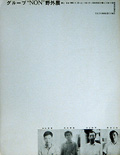| |
After Group Ko's anti-"fine art" movements, some members who left the group started their activity. During 1968-1972, they held open air exhibition
in a park or a river. Some artist piled up used tires, sticked coins to long
plywood wall, or filled a square with pressed cans. Those works reflected their anger or irritation against political situation in Okinawa, Japan and world.
Between late 1960's and early 70's, social conditions in Okinawa was
turbulent: Vietnam War broke out in 1965. B52s took off from Kadena Air
Base night and day, B52's crash in 1968, Cancellation 2.4 General Strike in
1969, Sato & Nixon Joint Communique stating the schedule of Okinawa
Reversion in 1969, Koza Riot in 1970. It may be a healthy reaction for the
young artists to have desire to express themselves directly using new style
during the time.
Although local journalism didn't pay attention to them very much, military issued news paper covered them with the caption "Angry young artists."
However, they did not have clear theory for their artistic practice. Mostof the members stopped work afterward. After all, avant-garde movement in
1960's came to end due to lack of supportive foundation.
|
 |